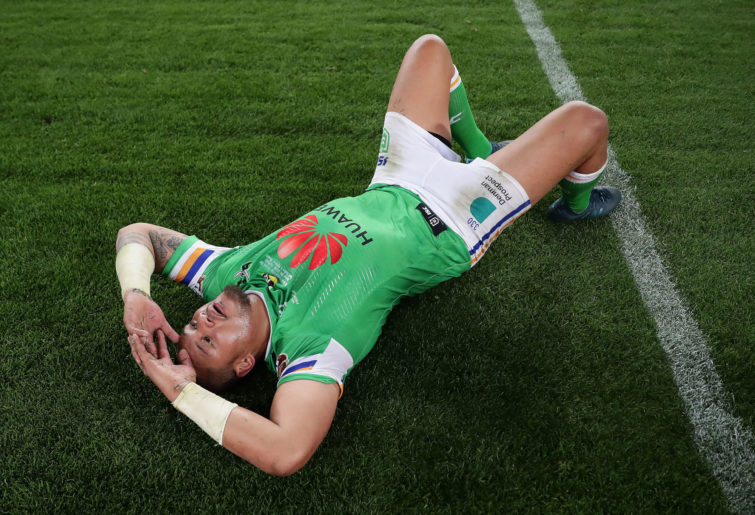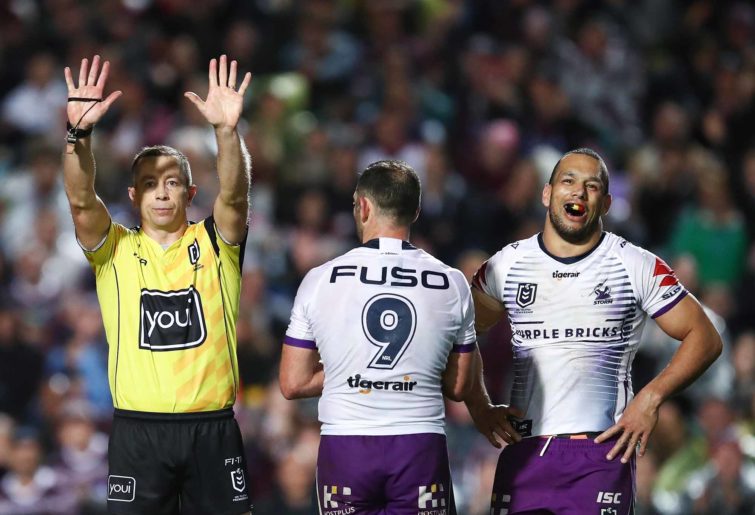With apologies to Raiders fans, six-again will become the most-used term once again when the NRL season returns in a fortnight.
The NRL announced on Wednesday that, from the beginning of Round 3, games will revert to a system where one referee takes charge and six-again will be used for ruck infringements instead of a penalty.
While I congratulate Peter V’landys and the commission for sticking their collective neck out on the line, it’s arguable that the decision to cut from two referees to one is not ideal.
Further to that, changing rules midseason is, well, it’s not exactly the best practice to get into moving forward for the sport.
But what will be will be, and 2020 will see the introduction of the six-again rule for ruck infringements, which frankly isn’t the worst change to bring in. It just should have been timed far better and will need some big tweaks to make it work.

(Mark Metcalfe/Getty Images)
Teams, coaches and players will become used to it, and the game will be better off for the six-again rule without minute-long stoppages after a team needlessly gives away a penalty on the goal-line for a break.
That’s right. Those penalties are given away with one objective: to have a break in defence. It’s not like a team wants to defend another set of six on their goal-line, but the alternative of a try being scored before they can reset the defensive line is one that teams have turned their nose up at for years.
However, goal-line penalties are the only circumstance where six again should be ordered. Let’s get that clear first and foremost before working through the other intricacies of how this rule should work in the competition.
What can be counted as the goal-line is up for dispute, but a ruck infringement given away inside of ten metres from the try line is probably the place to start.
These are the main instances of a team simply lying in the ruck to get a breather. Other than that, it’s really not carried out purposely by teams.
The last thing we want to see is a team giving away ruck infringements 70 metres from home on Tackle 1 and not really getting penalised for it.
Consider the following: Ken Maumalo or Blake Ferguson have just made a huge run back. They get tackled on the 30-metre line, 20 short of halfway. Now, instead of a penalty, the team can lay in the ruck, let their defence reset and get penalised only one extra tackle.
So for that reason ruck penalties should still exist, just not close to the try line when a team is on the attack and having their run snuffed out time and time again by illegal tactics.
There is also the small matter of teams being able to kick penalty goals – that should still be a part of the game – so penalties outside the attacking ten-metre zone would probably be the correct way to go.
Now, the key reasoning this has been brought in is to eliminate the ability to teams to gain an advantage by giving away sloppy and stalling ruck infringements close to the try line.
However, in its current format it simply will not work to that effect. Teams are still going to lay all over the ruck, take their sweet time getting off players and attempt to slow the game down. Six again will still give teams a chance to reset their defensive lines.
Defensive players will simply take even longer to get off players and out of tackles, while the drop to one referee will make these indiscretions even tougher to police.
No, if you want to eradicate this type of silly, needless behaviour from the game, you need much tougher penalties.

(AAP Image/Brendon Thorne)
The plan the NRL should be looking at with the removal of penalties is also the removal of players.
If an attacking team is going to get a proper advantage out of a penalty close to the try line, then it should be that a defensive player committing a ruck infringement is also removed from the game until either the next natural break in play – for example, a dropout, error et cetera – or their team gets the ball back.
It might be seen as harsh on the defensive team, but the bottom line is ruck infringements close to the goal-line just won’t happen. Players don’t want to leave their side defending one or possibly more men short.
In this solution two ruck infringements in the same passage of play would leave a team defending with 11, and not only that, but no break in between as play simply continues with six again.
The order would also be given that said player needs to get behind the dead ball line quickly, and if he interferes in the continuation of play, he will be placed in the sin bin for ten minutes instead.
It’s a simple solution which just screams to teams, ‘Don’t do it or you will concede a try’.
What this will also do is weed out the best teams from the worst. The fittest teams from the pack. If you’re going to keep your defence in order and not concede points, then teams best be prepared to defend without bending or breaking the rules.
There is of course the issue of referees allowing discretion when it comes to these events as they do currently in terms of blowing penalties, but in theory they simply won’t have to, because there won’t be many ruck infringements to call, so worried will players be about leaving their team defending short on the goal-line.
This is not something that will be brought in for this season, but when the six-again rule is shown to more than likely not work in its current state, changes will be made, and these could all help speed up the game more so, eliminating the chance of teams being able to have a breather and reset their defensive line almost completely.
It’s a surefire way to clean up the wrestling mess and make having one referee a viable option. To clean up the game because players are concerned by the punishments they face.
Up until now, they haven’t been, and moving into the second, revamped part of 2020, I strongly doubt they will be either.
More serve penalties are the way to go if the NRL want to make the six-again rule work.






























































































